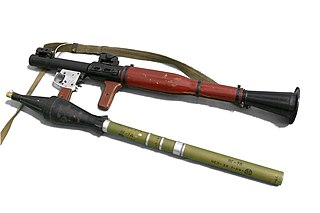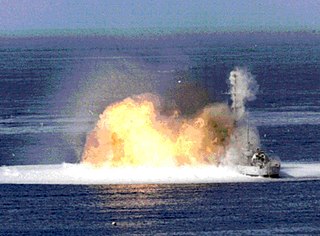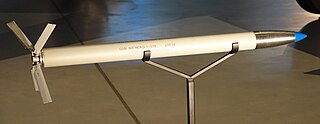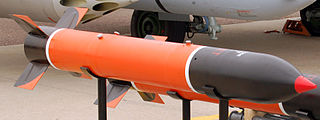
A rocket-propelled grenade (RPG) is a shoulder-fired rocket weapon that launches rockets equipped with an explosive warhead. Most RPGs can be carried by an individual soldier, and are frequently used as anti-tank weapons. These warheads are affixed to a rocket motor which propels the RPG towards the target and they are stabilized in flight with fins. Some types of RPG are reloadable with new rocket-propelled grenades, while others are single-use. RPGs are generally loaded from the front.

A thermobaric weapon, also called an aerosol bomb, or a vacuum bomb, is a type of explosive munition that works by dispersing an aerosol cloud of gas, liquid or powdered explosive. The fuel is usually a single compound, rather than a mixture of multiple substances. Many types of thermobaric weapons can be fitted to hand-held launchers, and can also be launched from airplanes.

R4M, abbreviation for Rakete, 4 kilogramm, Minenkopf, also known by the nickname Orkan due to its distinctive smoke trail when fired, was a folding-fin air-to-air rocket used by the Luftwaffe at the end of World War II.

The RPG-7 is a portable, reusable, unguided, shoulder-launched, anti-tank, rocket launcher. The RPG-7 and its predecessor, the RPG-2, were designed by the Soviet Union, and are now manufactured by the Russian company Bazalt. The weapon has the GRAU index 6G3.

The M270 Multiple Launch Rocket System is an American armored self-propelled multiple launch rocket system.

The MGR-1 Honest John rocket was the first nuclear-capable surface-to-surface rocket in the United States arsenal. Originally designated Artillery Rocket XM31, the first unit was tested on 29 June 1951, with the first production rounds delivered in January 1953. Its designation was changed to M31 in September 1953. The first Army units received their rockets by year's end and Honest John battalions were deployed in Europe in early 1954. Alternatively, the rocket was capable of carrying an ordinary high-explosive warhead weighing 1,500 pounds (680 kg).

The Mk 4 Folding-Fin Aerial Rocket (FFAR), also known as "Mighty Mouse", is an unguided rocket used by United States military aircraft. It was 2.75 inches (70 mm) in diameter. Designed as an air-to-air weapon for interceptor aircraft to shoot down enemy bombers, it primarily saw service as an air-to-surface weapon. The FFAR has been developed into the modern Hydra 70 series, which is still in service.

The RPO-A Shmel is a man-portable, single-use, rocket-assisted thermobaric weapon. While its name directly translates to flamethrower, the RPO-A Shmel is more accurately described as a thermobaric weapon. The Shmel is designed, produced and exported by the Russian Federation and previously by the Soviet Union. It entered service with the Soviet Armed Forces at the end of the 1980s as the successor for the RPO Rys.

The S-24 is a rocket weapon designed and used by the Soviet Air Force. It remains in use by the Russian Aerospace Forces, Ukrainian Air Force and many export countries. The name is based on the diameter of the rocket, 24 cm (9.4 in).

The S-8 is a rocket weapon developed by the Soviet Air Force for use by military aircraft. It remains in service with the Russian Aerospace Forces and various export customers.

The Mil Mi-28 is a Soviet all-weather, day-night, military tandem, two-seat anti-armor attack helicopter. It is an attack helicopter with no intended secondary transport capability, and is better optimized than the Mil Mi-24 gunship for the role. It carries a single gun in an undernose barbette, plus external loads carried on pylons beneath stub wings.

The RP-3 was a British air-to-ground rocket projectile introduced during the Second World War. The "3 inch" designation referred to the nominal diameter of the rocket motor tube. The use of a 60 lb (27 kg) warhead gave rise to the alternative name of the "60-pound rocket". Though an air-to-ground weapon, it saw limited use in other roles. They were generally used by British fighter-bomber aircraft against targets such as tanks, trains, motor transport and buildings, as well as by Coastal Command and Royal Navy aircraft against U-boats and ships.
RS-82 and RS-132 were unguided rockets used by Soviet military during World War II.

The Kh-25/Kh-25M is a family of Soviet lightweight air-to-ground missiles with a modular range of guidance systems and a range of 10 km. The anti-radiation variant (Kh-25MP) is known to NATO as the AS-12 'Kegler' and has a range up to 40 km. Designed by Zvezda-Strela, the Kh-25 is derived from the laser-guided version of the Kh-23 Grom. The Kh-25 remains in widespread use despite the apparent development of a successor, the Kh-38.

The Kh-59 Ovod is a Russian cruise missile with a two-stage solid-fuel propulsion system and 200 km range. The Kh-59M Ovod-M is a variant with a bigger warhead and turbojet engine. It is primarily a land-attack missile; the Kh-59MK variant targets ships.

The Zuni 5-inch Folding-Fin Aircraft Rocket (FFAR), or simply Zuni, is a 5.0 in (127 mm) unguided rocket developed by the Hunter-Douglas Division of Bridgeport Brass Company and deployed by the United States Armed Forces, and the French Air Force. The rocket was developed for both air-to-air and air-to-ground operations. It can be used to carry various types of warheads, including chaff for countermeasures. It is usually fired from the LAU-10 rocket pod holding four rockets.

The Falaq-1 is an Iranian-made rocket system.

The 2S4 Tyulpan is a Soviet 240 mm self-propelled heavy mortar. "2S4" is its GRAU designation. The Tyulpan is the largest mortar system in use today. It saw use in Afghanistan, Lebanon, Chechnya, and Ukraine.

The SNEB rocket is an unguided air-to-surface 68 mm (2.7 in) rocket projectile manufactured by the French company TDA Armements, designed for launch by attack aircraft and helicopters. It is also known as the SNEB rocket pod, and sometimes as the Matra rocket, due to it commonly being carried in pod-like launchers built by Matra.

A precision-guided munition (PGM), also called a smart weapon, smart munition, or smart bomb, is a type of weapon system that integrates advanced guidance and control systems, such as GPS, laser guidance, or infrared sensors, with various types of munitions, typically missiles or artillery shells, to allow for high-accuracy strikes against designated targets. PGMs are designed to precisely hit a predetermined target, typically with a margin of error that is far smaller than conventional unguided munitions. Unlike unguided munitions, PGMs use active or passive control mechanisms capable of steering the weapon towards its intended target. PGMs are capable of mid-flight course corrections, allowing them to adjust and hit the intended target even if conditions change. PGMs can be deployed from various platforms, including aircraft, naval ships, ground vehicles, ground-based launchers, and UAVs. PGMs are primarily used in military operations to achieve greater accuracy, particularly in complex or sensitive environments, to reduce the risk to operators, lessen civilian harm, and minimize collateral damage. PGMs are considered an element of modern warfare to reduce unintended damage and civilian casualties. It is widely accepted that PGMs significantly outperform unguided weapons, particularly against fortified or mobile targets.



























